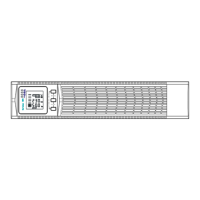
Do you have a question about the KStar MEMO PLUS RT II (MP9100RTII-0.9) 1-3K and is the answer not in the manual?
| Input Voltage | 220/230/240VAC |
|---|---|
| Output Voltage | 220/230/240VAC |
| Output Waveform | Pure Sinewave |
| Input Frequency | 50/60Hz |
| Output Frequency | 50/60Hz |
| Battery Type | Sealed Lead-Acid (SLA) |
| Battery Type & Number | 12V/9AH |
| Number of Batteries | 2 |
| Charging Time | 90% capacity after 4 hours |
| Communication Interface | USB/RS232 |
| Full Protection | Overload |
| Operating Temperature | 0 ~ 40°C |
| Humidity | 0 ~ 95% Relative Humidity (Non-condensing) |
| Noise Level | <45dB at 1m |
| Model | MEMO PLUS RT II (MP9100RTII-0.9) 1-3K |
Essential safety instructions and warnings for the UPS and its components.
Warnings concerning lethal voltages, electrical shock, fire risks, and safe operating environments.
Precautions for handling UPS batteries and guidelines for their proper disposal.
Procedures for inspecting equipment for damage, unpacking, and checking accessories.
Detailed steps for physically installing the UPS unit into a standard rackmount configuration.
Instructions for wiring installation, connecting internal batteries and optional EBPs.
Instructions for converting the UPS from a rackmount configuration to a tower configuration.
Steps to power on and initialize the UPS after installation, including self-test and basic setup.
Description of the UPS control panel, buttons, LCD display, and indicator lights.
Details on button functions, working status indications, and different operating modes.
Overview of LCD display sections and how to monitor UPS parameters.
Guide to configuring various UPS settings like ECO mode, bypass, voltage, and battery.
Procedures for starting up, shutting down, and performing self-tests on the UPS.
Guide to installing communication cards and connecting cables for UPS communication.
Description of available communication ports (RS-232, USB) and connectivity options.
Information on EPO feature and load segments for remote control and power management.
Guide to installing and using the UPS monitoring and management software.
Guidelines for maintaining the UPS and batteries for optimal performance and longevity.
Procedures and precautions for replacing UPS batteries and testing new ones.
Information on the proper disposal and recycling of used UPS units and batteries.
Overview of UPS models, power levels, and communication options.
Details on the UPS electrical input and output specifications, including voltage, current, and connections.
Information on environmental conditions, safety certifications, and battery configurations.
Description of typical alarm conditions, their causes, and recommended solutions.
Table of fault codes and their corresponding operating modes before the fault occurred.